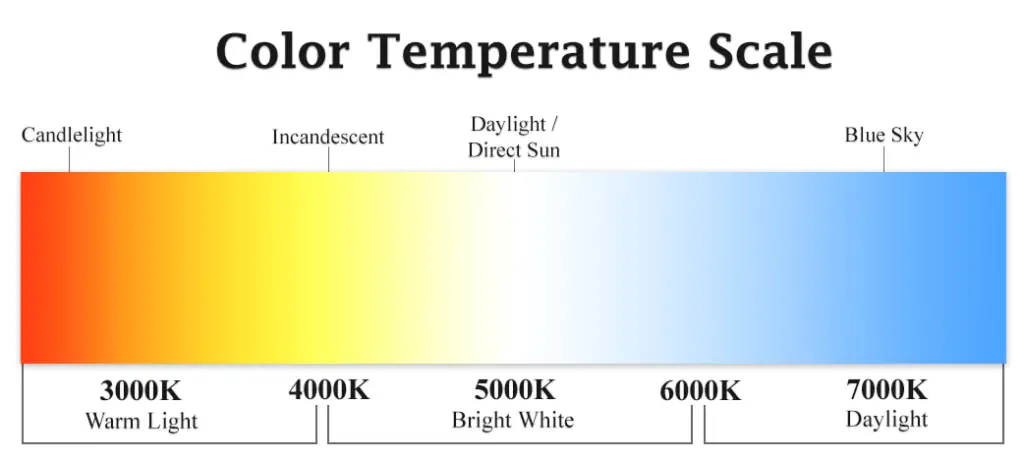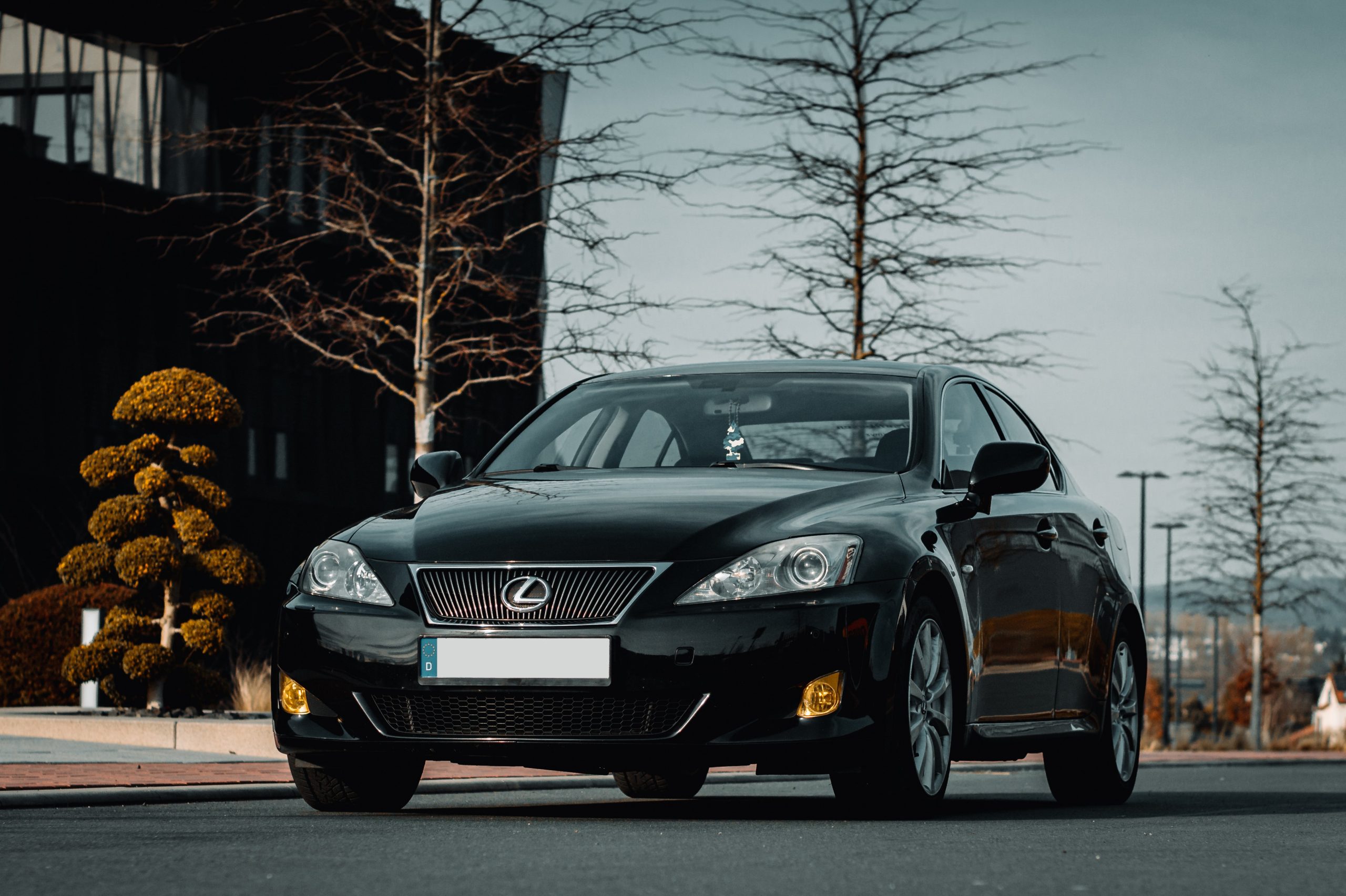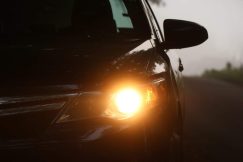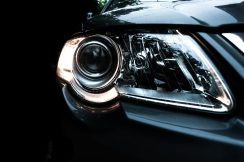Ever wondered, why are fog lights yellow? It’s common to see fog lights that are not the same color as the headlights. Headlights are typically white, while some fog lights are yellow. What’s that about? We’re going to help you understand the science behind yellow fog lights.
The Purpose of Fog Lights
Fog lights are a common feature on many cars and trucks, and they are designed to help improve visibility in foggy or misty conditions. These lights are typically mounted low on the vehicle, near the front bumper, and they are pointed downwards at a sharp angle. One of the most distinctive features of fog lights is their yellow color, which sets them apart from the white or blue headlights typically used on vehicles.
Why Are Fog Lights Yellow?
But why are fog lights yellow? The answer lies in the science of light and how it travels through different types of atmospheric conditions. When light passes through the air, it can be scattered or absorbed by particles in the air. This is why objects appear hazy or blurry when viewed through fog or mist.
Different colors of light are scattered by different amounts when they pass through the air. Blue and violet light, for example, are scattered more easily than red and yellow light. This means that when light passes through fog or mist, the blue and violet wavelengths are absorbed and scattered more, leaving the red and yellow wavelengths to pass through more easily.
As a result, yellow light is less likely to be absorbed or scattered by fog or mist, and it can travel further through the air without losing its intensity. This makes it more effective for illuminating the road and objects near the vehicle, helping drivers to see and avoid potential hazards.
In addition to its improved visibility in foggy conditions, yellow light is also less likely to cause glare or discomfort to other drivers. White and blue light can be very bright and can cause glare when reflected off of fog or mist, making it difficult for other drivers to see. Yellow light, on the other hand, is less intense and is less likely to cause glare, making it safer for use in foggy conditions.
Types of Yellow Fog Lights
Yellow fog lights are a type of automotive light designed to increase visibility in foggy or misty driving conditions. There are several kinds of yellow fog lights available on the market today, including halogen, LED and HID (High Intensity Discharge) bulbs.
Halogen
Halogen yellow fog lights provide a bright yellow light that is capable of penetrating through thick fog or mist. The bulbs produce a bright, clear beam of light that can help improve visibility in foggy conditions by providing a wide spread of light while still effectively illuminating the road ahead.
LED
LED yellow fog lights are becoming increasingly popular due to their long lifespan and low power consumption. They provide similar performance to traditional halogen bulbs but with more color saturation, making them ideal for creating a distinct visual style.
HID
HID yellow fog lights are perfect for those who want maximum performance in terms of brightness and color temperature. These bulbs offer an intense white-yellow light which penetrates further into the night and has more intensity than other types of bulb technologies.
All three types of yellow fog lights provide improved illumination in night driving conditions as well as better visibility when driving through dense fog or mist – helping make driving safer for everyone on the road.
Understanding Color Temperature
Color temperature is a concept that can be used to understand the visible light spectrum. It is often described as the “temperature” of the visible light and is measured in units of Kelvin (K). This measurement system can help us determine the color of a certain light source and how it affects our environment.

The color temperature of a given light source is based on its spectral power distribution, which is determined by its composition. The spectral power distribution describes how much energy each wavelength emits, using the total amount of energy emitted to measure its color temperature. Different colors emit different amounts of energy at varying wavelengths, so it is important to understand what kind of lighting you are working with when considering color temperature.
Generally speaking, lighting sources tend to have either a warm or cool tone associated with them. Warm colors tend to be seen in the yellow-orange-red region on the visible light spectrum while cool colors are found in the blue-indigo-violet region. Each of these regions corresponds to certain color temperatures in Kelvin; for instance reds range from 2200K – 3000K while blues range from 8000K – 10000K.
It’s important to note that although a higher color temperature may provide more illuminance than a lower one, lighting with cooler temperatures can appear brighter because they contain more short wavelength light than warmer ones. This means that if your goal is cripping bright illumination, then you may want to choose lighting sources with higher Kelvin ratings such as 10,000K or 20,000K since they will provide more intense bright lights than lower rated ones like 2050K or 2700K would produce.
Different environments also require different types of lighting for best effect; for instance high-end commercial spaces use 4000 – 5000 K lights because their pure white illumination enhances merchandise presentation and creates an inviting atmosphere whereas residential spaces typically prefer 2200 – 3000 K lights which offers softer and cosier environment. Additionally interior designers often use 2700 K lamps as they produce pleasant warm tones without sacrificing too much brightness which makes them perfectly suitable for comfortable living areas or bedrooms.
So as you can see, understanding color temperatures and their relationship to the visible light spectrum is essential when selecting lighting sources for any space; whether it be home interiors or commercial settings! With this knowledge you will be able to create just the right ambience desired with optimal illumination quality.
The Pros of Yellow Fog Lights
The pros of yellow fog lights are that they make it much easier to drive in poor visibility conditions, such as dense fog. Yellow light penetrates the fog better than other colors, allowing drivers to see roadways, hazards and other vehicles more clearly. This increased safety is especially beneficial when traveling at night.
Yellow fog lights also have an aesthetic appeal, as the color is often associated with sunlight and brightness. Many people find the color yellow calming and this can be reflected in their driving experience. The yellow hue is also quite stylish, which can improve the look of a vehicle.
The Cons of Yellow Fog Lights
However, there are some cons to using yellow fog lights. One of the main issues is that they can be blinding if used in close proximity to another vehicle or driver, as the light does not disperse as quickly as a white light would in those conditions. Additionally, some drivers may not prefer the look of the yellow hue compared to more traditional white headlights and tail lights.
Finally, many countries have strict laws regarding what types of lighting are allowed on roads and highways so motorists should always check their local regulations before installing any type of lighting system on their vehicles. In some places yellow fog lights may be illegal to use while driving on public roads and highways due to potential risks posed by excessive brightness or glare from other drivers.
Yellow Fog Light Buying Guide
When it comes to fog light bulbs, yellow is a popular color choice due to its distinct hue and brightness. A yellow fog light bulb can help make your driving experience safer by increasing visibility in low-light conditions. In this buying guide, we’ll take a look at some of the important things you should consider when shopping for yellow fog light bulbs, including
- Types
- Brightness
- Wattage
- Lifespan
- Other factors
Types
When it comes to types of yellow fog light bulbs, there are two main options: halogen and LED. Halogen bulbs are generally less expensive than LEDs and offer a warm white/yellow glow that penetrates through fog better than any other type of bulb. However their life expectancy is shorter than LEDs (usually around 500-1000 hours) and they consume more energy. LED bulbs last significantly longer (up to 50,000 hours) and require less energy but tend to be more expensive initially. The decision between halogen or LED really depends on your needs and budget.
Brightness
In addition to type of bulb, you’ll also want to consider the bulb’s brightness or lumens output. The brightness for both halogen and LED bulbs can range from about 10-12000 lumens. The higher the lumen rating the brighter the bulb will be which results in better fog penetration but also higher consumption rates. It’s best to find a balance between brightness and energy consumption while still achieving the desired clarity in your environment when driving in low-light conditions like foggy nights or during heavy rainstorms.
Wattage
Wattage is another important factor when selecting yellow fog light bulbs as well since it impacts how much electricity you’ll need to power them up. Generally speaking, halogen bulbs require more wattage than LED ones – usually upwards of 40 watts per pair while LEDs draw much less power typically ranging from 5-20 watts per pair depending on their lumen rating which we discussed earlier.
Lifespan
Finally you’ll want to think about the lifespan of your chosen bulb as it ties into both cost savings over time as well as general convenience when not having to replace them too often. As mentioned previously halogen bulbs typically only last between 500-1000 hours while LEDs can last up 50,000 hours if used correctly – that means potentially replacing your halogens anywhere from 25-50 times before needing one set of LEDs.
Other Factors
When shopping for yellow fog light bulbs there are many factors you should take into consideration including type (halogen vs LED), lumens output for desired brightness without overconsumption of electricity, wattage requirements for installation/setup purposes and finally lifespan which plays an important role in overall costs savings throughout time especially when comparing halogens with LEDs which have far superior lifespans at roughly 50x longer than regular halogens.
Taking all these factors into account will ensure that you find the best fitting bulb(s) for your vehicle’s needs while getting maximum performance out of them without breaking bank – something every driver desires.
How to Install Yellow Fog Light Bulbs
Installing fog light bulbs in a car is a relatively simple process that can be completed in just a few easy steps.
1. Start by turning off the power to the vehicle, either by disconnecting the battery or by switching off the circuit breaker for your car’s headlights.
2. Next, remove the screws that are holding in the fog lights housing and carefully remove it from your vehicle. It’s important to make sure you wear gloves and keep any dirt or debris away from the headlight so you don’t accidentally damage it.
3. After taking out the housing, you should be able to locate the fog light bulb inside of it. Disconnect it from its holder and then check to make sure it isn’t burned out before proceeding with installation.
4. Now take your new fog light bulb and plug it into its holder before placing it into the headlight housing gently. Make sure not to force it in or else you could end up damaging both the bulb and its holder.
5. Once everything is connected, carefully put back on the fog light housing and fasten it using the screws that were removed earlier. Make sure they are tight enough but don’t over-tighten or strip them as this could cause problems down the road as well as potentially damage your vehicle’s lighting system.
6. Finally, turn back on your vehicle’s power source again so you can test out your new fog light bulb! You should now have bright, clear visibility when driving at night or during inclement weather conditions thanks to this simple upgrade.
FAQs
Are yellow fog lights legal?
There is no definitive answer to this question since the legality of yellow fog lights can vary from state to state. In some states, yellow fog lights are illegal, while in others they are allowed but only for specific purposes. For example, in California, yellow fog lights are allowed as long as they are used in conjunction with white headlights. It is always best to check with your local law enforcement agency to find out if yellow fog lights are legal in your area.
Are yellow fog lights better?
There is no definitive answer as each driver’s needs and preferences vary. Yellow fog lights are said to be better because they help to cut down on glare and improve visibility in foggy conditions. They also make it easier for other drivers to see you. Additionally, yellow fog lights can provide better visibility in areas that have a lot of dust or sand in the air.
However, there are also white fog lights that some people prefer because they don’t add any extra colors to the light and make it easier to judge distances. Ultimately, it comes down to personal preference so it’s best to try out both types to see which one works best for you. Whichever one you choose, be sure to use it responsibly and drive safely.
Where are the fog lights on a car?
Most cars have the fog lights on the front bumper, near the headlights. Some cars also have fog lights on the side of the car, near the turn signals.
What is the difference between yellow and amber fog lights?
There is no difference. They are the same thing.
Conclusion
Overall, the yellow color of fog lights is not just a matter of aesthetics. It is a carefully chosen color that is designed to improve visibility and safety in foggy or misty conditions. By using yellow light, fog lights are able to penetrate the fog and illuminate the road more effectively, helping drivers to see and avoid potential hazards.




